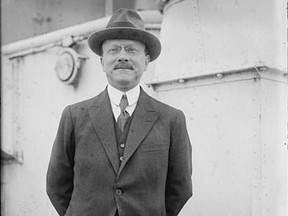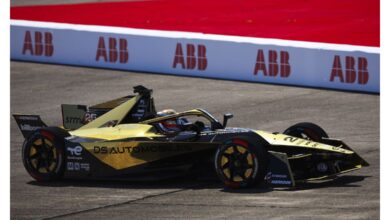Igniting the Automobile: Citroen, the ‘Henry Ford of France’

Article content
Innovation is a hallmark of car design, creating impressive vehicles that grab the discerning customer’s eye. Producing aerodynamic cars that pushed the envelope of style and originality, Andre Citroen entered the automobile market in France in 1919. Focusing initially on performance in championships, the Citroen firm became a leader in manufacturing striking vehicles.
Advertisement 2
Article content
Living in France in the 1800s, the family name of Citroen was derived from the Dutch name “Limoenman,” meaning “lime man.” While the name resembled citrus fruit, the high-quality automobiles designed and manufactured by Citroen were far from lemons. The superior vehicles developed a devoted fan base across the globe.
Article content
Andre-Gustave Citroen “was born in Paris on 5th of February 1878 to Levie Citroen, a diamond merchant of Dutch Jewish origin, and Amalie Kleinmann, a Jewess of Polish origin,” stated Julian Marsh in “A Brief History of Citroen, Page 1,” at Citroenet. Andre was the youngest child of five; their father died when the boy was only six years old, and their mother died when he was about age 21.
The technologically skilled Citroen graduated from Ecole Polytechnique in 1900, then tackled his one year of compulsory military service. Posted to the 31st Regiment at Le Mans, Citroen was an artillery sub-lieutenant. Itching to work on his own business ideas, the soldier often visited the nearby automobile factory of Amedee Bollee. The French automaker manufactured “a six-cylinder Type 30/40 petrol-engined luxury car, which later came to be regarded as a serious rival to the Rolls-Royce,” wrote John Reynolds in “Andre Citroen: The Man and the Motor Car” (Alan Sutton Publishing Limited, 1996).
Advertisement 3
Article content
Establishing his own engineering firm, by 1905, Andre Citroen & Cie was manufacturing an order of “five hundred motors for the Paris-based car-makers Sizaire and Naudin,” Reynolds said.
Visiting family in Poland, Citroen observed a workman making a set of gears with a unique herringbone structure. The gears worked smoothly and with less noise. Citroen was excited. He purchased the patent from the man for a small price and established a factory to produce the metal parts. The chevron-style image of the gears became the Citroen company logo.
In 1913, Citroen married 21-year-old Giorgina Bingen, a vivacious, sophisticated young woman nearly half his age. At his factory near the Seine River, Citroen introduced his first car. The Citroen Type A sprinted along at 40 m.p.h. (60 km/h) with a 10-horsepower motor. Manufacturing just over 24,000 Type As at the Paris factory from June 1919 until December 1921, Citroen’s popular four-metre-long long vehicle weighed 810 kilograms. The hustling factory workers produced about 100 cars per day.
Advertisement 4
Article content
Making history in Europe, Citroen used assembly-line mass production to build his first car, earning the moniker of “the Henry Ford of France.” Rare for the time, the automobile “came fully equipped with tyres, lamps and even a self-starter, ready for the road,” Reynolds said. Later, the car was offered in several styles using the same chassis, engine and transmission. The Citroen Type A was the first European car to have the steering wheel mounted on the left side. Emperor Napoleon had dictated that the steering wheel be on the right side, noted Reynolds, “so that the driver or chauffeur could see the edge of the poorly made roads.”
During the First World War, auto manufacturing was halted for military purposes. Among others, the Citroen and Renault factories produced munitions. Within a short time, Citroen made a proposal to help the French government meet the exploding need for shells. With government backing, he constructed a plant from the ground up, brought in machinery and hired workers to assemble ammunition. It was new territory for Citroen, and he flourished. By the end of the war, the factory had produced 23 million shells; the entrepreneur returned to automaking.
Advertisement 5
Article content
Citroen did not design vehicles himself; he hired talented engineers. Audacious and colourful, he was a brilliant marketer. He debuted his next automobile with panache at the 1921 Paris Motor Show. High over the city and the Eiffel Tower, an airplane pilot scrawled “Citroen” in giant letters in the sky.
The dramatic advertising continued with Citroen’s next vehicle, a half-track model that made news in 1922 by crossing the Sahara Desert. Within two years, the company was manufacturing 50,000 vehicles a year.
Fresh designs frequently rolled off Citroen’s assembly lines. “In order to avoid punitive import charges on his products,” Citroen “set up factories in Belgium, Britain, Germany and Italy,” according to Citroenet. Demolishing his French factory in 1933, Citroen built a new plant on the site, “without impacting on production,” while still “developing a revolutionary new car, the Traction Avant.”
Advertisement 6
Article content
A trendsetter, Citroen established a network of dealers across France to service his company’s vehicles. Concerned for his workers’ welfare, he organized “medical and dental facilities and a gymnasium in his factories,” said Citroenet. He also provided daycare for employees’ young children.
Taking ill, Citroen was diagnosed with stomach cancer, and surgery was unsuccessful. As he grappled with the disease, the company struggled after the Traction Avant debuted with poor sales. The Citroen company filed for bankruptcy. The colossal Michelin tire company took over operations.
Andre Citroen did not live to see the remarkable revival of his company. The 56-year-old died in Paris, France, on July 3, 1935. Citroen was survived by his wife and four children. The obituary in the Daily Telegraph described him in glowing terms, stated Reynolds. “By sheer ability, he succeeded in making his previously unknown name almost as famous as any in Europe. … No enterprise was too great for Andre Citroen.”
Advertisement 7
Article content
Under the direction of Pierre Jules Boulanger, the Citroen company continued the drive towards rebuilding and regaining position in the market. Designed beyond the ordinary, Citroen’s vehicles remained futuristic, with modernizations such as hydropneumatic suspension systems.
During the Second World War, the Nazis overtook France and demanded a halt of the Citroen company’s production line, replaced by German auto assembly instead. Boulanger was unco-operative. He fearlessly supported sabotage of the Nazi trucks by slowing worker output. He also approved renotching dipsticks so that it seemed there was sufficient oil but the actual level was much too low. The enemy’s engines soon ran out of oil and seized.
Advertisement 8
Article content
Over the next decades, the Citroen company endured changes in production and ownership. Boulanger was killed in a car accident, and the company was restructured. Citroen joined with Fiat, and then purchased the Maserati firm. In the 1970s, the company merged with Peugeot. The pioneering design advantage was lost in the shuffle.
The sleek Citroen models appeared on Canadian roads in the 1960s and 1970s with the establishment of Citroen Canada in Montreal, Que. Sales did not support the effort.
In 2021, Citroen became part of Stellantis. The manufacturer is transitioning into the electric vehicle market in Europe with steadily growing sales, and the Citroen name lives on.
Susanna McLeod is a writer living in Kingston.
Article content



